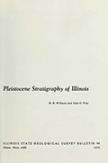Historical:Lacon Formation
Lithostratigraphy: Lacon Formation
Chronostratigraphy: Cenozoic Erathem >>Quaternary System >>Holocene Series
Authors
H. B. Willman and John C. Frye
Name origin
The Lacon Formation, named for Lacon, Marshall County.
Type section
The type section is a landslip area along the base of the bluffs of the Illinois Valley 2 miles northwest of Lacon, E½ Sec. 2, T. 12 N., R. 9 E., described by Ekblaw (1932a).
Stratigraphic relationships
At some places the deposits of the Lacon Formation grade into or intertongue with the sediments in the Cahokia Alluvium and the Peyton Colluvium, but the formations are separated by vertical cutoff.
Lithology
It consists of deposits that are dominantly gravity-initiated, such as landslides, slumps, slips, rock falls, and mudflows. Only those deposits that are surficial or covered by slopewash are included in the Lacon Formation.
Ground water is the lubricating agent for most of the movements that formed the Lacon Formation. The deposits consist of disturbed masses or broken fragments of locally derived rocks. The Lacon Formation varies from deposits in which the source rocks are mixed, such as many talus deposits, to those resulting from mass movements that only slightly disturbed the original materials. If cemented, the deposits would be called breccia.
Age and correlation
The Lacon Formation is Wisconsinan and Holocene in age. Some of the deposits probably were initiated by the rigorous periglacial climate and still continue to accumulate.
References
EKBLAW, G. E., 1932a, Landslides near Peoria: Illinois Academy of Sciences Transactions (1931), v. 24, no. 2, p. 350-353.
ISGS Codes
| Stratigraphic Code | Geo Unit Designation |
|---|---|
